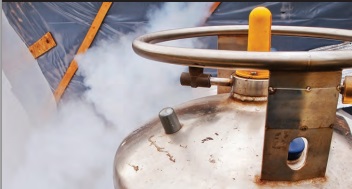Chapter: Fiber Optic Sensing, new invention technology, Research project papers,
Cryogenic FOSS (CryoFOSS)

Cryogenic FOSS (CryoFOSS)
Armstrong innovators have developed a highly accurate method for
measuring liquid levels using optical fibers. Unlike gauges that rely on
discrete measurements to give broad approximations of liquid levels,
Armstrong's novel method provides measurements at 0.25-inch intervals within a
tank. The system uses FBG sensors located along a single fiber optic cable.
These sensors actively discern between the liquid and gas states along a
continuous fiber to pinpoint the liquid level. This significant leap forward in
precision and accuracy in liquid level sensing offers important benefits to
many industries. Designed to monitor a rocket's cryogenic fuel levels, the
technology can be used in many medical and industrial applications.
Work to date: The technology has
been demonstrated in multiple environments using conventional
validation techniques. First, water level measurements have been conducted to
demonstrate operation within a benign environment. Second, liquid level
measurements were conducted in liquid nitrogen using a 6-foot dewar.
Measurements also were conducted within a liquid hydrogen environment using a
4-foot dewar. The technology performed well in all three cases, demonstrating
the ability to measure liquid to 0.25 inches.
Looking ahead: The team continues to
push the technology's fields of application, with future tests to
determine boundary layers between different fluids, such as oil and water.
Benefits
Precise: Requires just one fiber optic
strand and one metallic wire
Safe: Is not susceptible to
electromagnetic interference
Robust: Can be used in
corrosive or toxic liquids
Applications
Aerospace launch vehicles and
satellites Chemical and refinery plants
Industrial tanks
Fiber Optic Sensing
Armstrong's portfolio of Fiber Optic Sensing System (FOSS)
technologies offers unparalleled options for high-resolution sensing in
applications that require a unique combination of high-powered processing and
lightweight, flexible, and robust sensors. The system measures real-time
strain, which can be used to determine two-dimensional and three-dimensional
shape, temperature, liquid level, pressure, and loads, alone or in combination.
Initially developed to monitor aircraft structures in flight, the system's
capabilities open up myriad new applications for fiber optics-not just in
aerospace but also for civil structures, transportation, oil and gas, medical,
and many more industries.
The Armstrong approach employs fiber Bragg grating (FBG)
sensors, optical frequency domain reflectometry (OFDR) sensing, and
ultra-efficient algo-rithms (100 samples/second). Engineers are continually
seeking new ways of looking at information and determining what is important.
Armstrong's FOSS technologies focus on critical research needs. Whether it is
used to determine shape, stress, temperature, pressure, strength, operational
load, or liquid level, this technology offers ultra-fast, reliable
measurements.
Related Topics